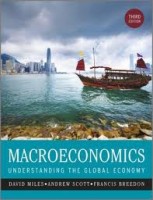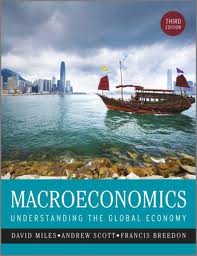 Authors: David Miles, Andrew Scott and Francis Breedon
Authors: David Miles, Andrew Scott and Francis Breedon
Publisher: John Wiley & Sons – 601
Book Review by: Sonu Chandiram
I find macroeconomics, the study of countries’ economic data and accounts, extremely fascinating. Microeconomics on the other hand relates to numbers about individuals, companies, organizations and other small entities, which is also interesting but not as much, to me.
This highly informative book makes the study of macroeconomics interesting because it relates various theories to facts and data, or better still, makes theories come alive by giving examples.
Concepts such as consumption and investment, current and trade account surpluses, deficits and debt, exports and imports, growth and shrinking of the gross domestic product (GDP), inflation and deflation, taxes and government spending and other pairs of factors can easily be understood in this book because they relate to actual data shown in charts, pertaining to particular countries.
In this book, you learn what is measured in macroeconomics; what are national income accounts and cross-country income differences; the importance of economic growth and its long-term impact on the wealth of nations; how capital is accumulated and how it is invested to increase a country’s GDP, and how currency exchange rates, prevailing costs of borrowing, savings levels and government spending affect it.
Some of the other important factors discussed in this book that play roles in a country’s economic life are:
Banking; bond yields; bubbles; business cycles; credit and credit risks; cost of living; education; emigration; fiscal policy; globalization; government debt, deficits and spending; health of its people; healthcare costs; human capital; immigration; income tax rates; interest rates and yields, international trade; investment; labor productivity; money printing, stabilization and supply, including inflow and outflow; national competitiveness and consumption; natural resources, prices of products and services; property tax levels; savings disincentives and incentives; sovereign debt and default, stock markets; and last but not the least, unemployment, both actual and official.
Would you like to know which countries have the largest slices of the world’s total economic pie? Which have the smallest shares? Whose slices will become the largest by 2050? Which are the world’s largest net debtors and which have the largest piles of money relative to their GDP? Then get your copy of Macroeconomics: Understanding the Global Economy.
This is a delightfully informative book!
I typically browse through a book – comments on its back cover, contents pages, charts and images inside, preface and conclusion – before reading parts of it.
I especially love to discover comparative economic data among countries. And in the back pages I was pleasantly surprised to discover charts on the top 10 countries in terms of each of these 16 factors:
Highest incomes, lowest incomes, happiest, least happy, most equal, least equal, least corrupt, most corrupt, highest life expectancy, lowest life expectancy, lowest government debt, highest government debt, lowest inflation, highest inflation, largest current account surplus, and largest current account deficit.
All the charts reporting the “good news,” – the positive charts – are on a single page. These are the first-mentioned items in the pairs, e.g. highest income, happiest, most equal, least corrupt, etc. And all the charts reporting the “bad news” – the negative charts – are placed together on a different page.
So I was curious to find out (as I am sure you are as well) how the United States is faring in terms of these 8 pairs of factors in the world of nations.
In the eight positive factors: I was not surprised to find that the U.S. was not in any of these charts. In other words, the U.S. is not among the top 10 highest income, happiest, most equal, least corrupt, highest life expectancy, lowest government debt, lowest inflation, and largest current account surplus countries.
And the U.S. was also not found at any rank in any of the eight negative charts. I was expecting to find it in the “highest government” debt chart, which presents “general gross debt as a percentage of that country’s gross domestic product or GDP.” But the U.S. was not in any of these eight charts. Most of the positive and negative charts were developed in 2011, while some others were created a few years prior to that.
The worst situation in terms of this factor was Japan which ranked No.1, whose government debt was more than 223 percent of its GDP in 2011. In No.10 place was Portugal, whose debt was 106 percent of its GDP. If these charts were created today, the U.S. may probably be included in this undesirable chart of the top 10 nations having the highest government debt. Why? Because the current U.S. government debt of $16.817 trillion is 107 percent of its $15.697 trillion GDP. Go to: www.USDebtClock.org
Pie charts at the end of the book reveal some eye-opening and even shocking information on countries, both in 2010 and projected for 2050:
- In 2010, the top three countries with the largest shares of the world’s economic pie were: the U.S. – 23%; China – 10%; and Japan – 10%
- In 2050, the top three countries with the largest shares of the world’s economic pie will be: China – 33%; the U.S. – 13%; and India – 10%
- In 2010, the top three countries with the largest shares of the world’s population were: China – 20%; India – 17% and the U.S. – 5%
- In 2050, the four countries with the largest shares of the world’s population will be: India – 19%; China – 12% and a tie between the U.S. and Saudi Arabia –7% each.
- In 2010, the top six sources of emigrants by country were: India and Bangladesh – 11% each; China, Mexico and Pakistan – 7% each; and Indonesia – 5%.
- In 2010, the top eight destinations of emigrants by country were: U.S.–18%; UAE–11% Spain – 8%; Australia, Canada, Russian Federation, Saudi Arabia, UK– 4% each.
An interesting and unique fact is that in 2010, the United States had the largest – 42 percent – of the share of world military expenditure. China had 7 percent. France, the Russian Federation and the UK each had 4 percent; Germany, India, Japan, and Russian Federation each had 3 percent, and Italy had 2 percent.
This large book of 21 chapters provides a very comprehensive view of what macroeconomics covers. Its numerous images break up the text that let you focus on a single concept and learn it well. There’s also a very helpful 12-page Glossary at the end.
It also has case studies. For example, it explains to you on pages 197-198 how trade liberalization measures enacted in 1991 by India’s government led to the country’s rapid rise. Prior to 1997, India’s growth was stunted by high tariffs, strict licensing requirements and unbreakable government monopolies. But once these were lifted, a chart shows you how liberalization helped shoot up the per-capita GDP by more than 250 percent from 1991 to 2009.
The authors of this book – David Miles, Andrew Scott and Francis Breedon – have produced an excellent work that’s highly useful not only to economics students but to the general public as well. This can be of tremendous benefit to you and help you personally make the right decisions to improve your economic life.







